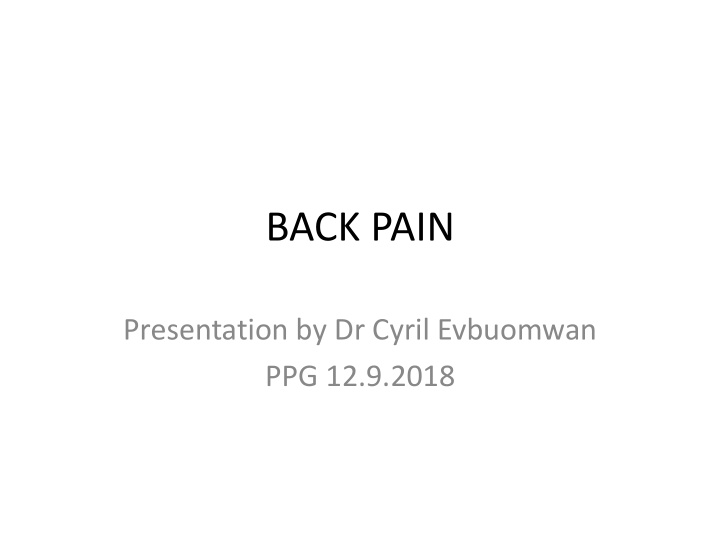



BACK PAIN Presentation by Dr Cyril Evbuomwan PPG 12.9.2018
What is back Pain • It is a common problem which affects 4 out 5 people at some point. • Often caused by simple strain in muscle, tendon or ligaments • It can be acute(sudden onset) or chronic lasting weeks and often on and off. • Structure – Back is designed to give strength and flexibility to the body. – It is made of 33 bones stacked on each other with disc as cushion, supported by lots of strong ligament and muscles – On each side of the bone are small joints called facet joints – The bones, disc and ligaments all age as we grow older
Causes of back pain • Commonest cause is simple strain in the muscle, tendon and ligament- simple back pain. This may result from bad posture, lack of exercise • Spondylosis: This is the type of back pain which results from wearing of the bone, disc and facet joints. The spaces between the bones become narrow. • Sciatica: The back pain travels to the leg because of the irritation or compression of the nerves in the back • Spinal Stenosis: This is the type of back pain which starts when you wake up in the morning. It settles quickly as you sit down • Other rare causes of pain are – Tumour – Infection like Tb – Inflammation – Trauma resulting infracture
Back Pain: When should I see the Doctor • The commonest cause of back pain is simple strain. You don’t need to see the doctor except • It is lasting for a long time • Affecting everyday activities
Back Pain: When should I see the Doctor • Very rarely back pain can be a sign of a serious problem. So see the doctor if you • If you have problem controlling or passing urine • If you cannot feel(numbness) around the anus or genitals • Lose control of your bowel • Have weakness of your legs or unsteady on your feet • Have pain which has become very severe over the weeks • These are what we call RED FLAG Signs
Back pain: How can I help myself • Pain Killers – Paracetamol 2 4 times a day(max 8 tablets) – Ibuprofen 400mg 3 times a day-can upset stomach – Use when necessary, regularly and at the right dose – Can use up to 7-10 days. If no relief then unlikely to help – Can also use gel to rub into the area
Back pain: How can I help myself • Exercise: The most important way to help the back pain. • It enables the body to heal itself-Endophins • Start slowly and build up the exercise • It may feel sore initially after exercise but it will improve • It is important to continue the exercise even when the pain stops. It helps to strengthen your back and improves fitness • Exercise includes – Walking – Swimming – Yoga and pilates – Gym
Back Pain: Diagnosis • As most back pain is simple, no test is necessary. A check by the doctor is enough. • The doctor will request test if – Injury is suspected – There is a possible cause MRI or CT scan is the best test X-ray for back pain is not useful because most causes of soft tissue Most changes on x-ray may not be the cause of the pain as they occur with age
Back Pain: Available treatments • Physical Therapies – Physiotherapy – Occupational Therapy Drugs Paracetamol/ ibuprofen Amitriptyline-relaxes muscle Gabapentin/Pregabalin Steroid injection Surgery only for 2% of patients need surgery
Back Pain: Outcome • 75-90% of patients with back pain will recover within few weeks. • For those with pain for a long time, the pain is likely to be present-chronic. • Going back to work help with back pain recovery • If you respond emotionally to back pain, recovery will be slow. • Sometimes anti-depressant helps with chronic pain
Back pain: Summary • ▪ Back pain is common but most cases aren't caused by a serious problem. • ▪ Most cases of back pain get better on their own within a few weeks. • ▪ Stay active. Bed rest for more than a couple of days makes it harder to get going. Gradually increase your normal activities and do regular exercise. • ▪ Take painkillers if needed so you can stay active. • Your pain should ease within 2 weeks and you should recover over approximately a 4-6 week period. • You should carry on with the exercises for at least 6-8 weeks to help prevent another injury. • If the pain is severe or not improving after a week or so, contact your doctor • Reference Arthritis Research UK
Recommend
More recommend